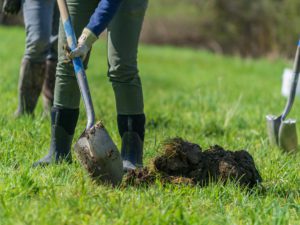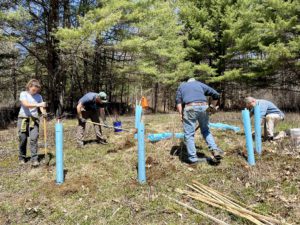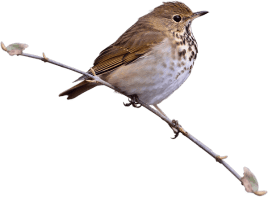Nearly 1,600 trees and shrubs planted, thanks to volunteers and partners
Volunteers planted nearly 1,600 native trees and shrubs in Barre, East Montpelier, Westminster, and Brattleboro this spring. The goal is to boost clean water by restoring wetlands and streams, and to improve wildlife habitat.
Community members and conservation partners planted trees and shrubs along tributaries of the Winooski River and the Connecticut River. They completed these restoration projects on Old Soul Farm in Barre, Fairmont Farms in East Montpelier, and former farm fields in Westminster and Brattleboro.
A partnership effort to re-forest land
“We’re working with farmers and partners across the state to re-forest some land along streams and wetlands,” said Allaire Diamond, an ecologist with the land trust. “Those forests can keep water clean downstream, by slowing down water and absorbing nutrients.”
Many partners came together for these projects, including Friends of the Winooski River, US Fish and Wildlife’s Partners for Fish and Wildlife program, the Windham County Natural Resources Conservation District. In addition, over 60 volunteers from Ursa Major Skincare, SunCommon, the ECO AmeriCorps program, the Vermont Housing & Conservation Board, and local communities joined in.
Barre and East Montpelier farms: Volunteers plant trees for clean water
“It’s part of our responsibility to the local and global community to volunteer on projects like this,” said Natasha Yandow of Ursa Major Skincare, who volunteered at Old Soul Farm in Barre. “After all, water connects us all.”
At Old Soul Farm, volunteers planted 800 trees on a former hayfield. The trees were planted alongside a wetland and along a stream of the Stevens Branch of the Winooski River, which flows into Lake Champlain. At Fairmont Farm in East Montpelier, volunteers planted 200 trees on a section of former hayfield that is along a tributary of the Winooski River.

Restoring these streams can have an outsized impact on clean water in larger rivers. The trees will help filter excess nutrients from farms, yards, and other development, before those nutrients reach the bigger, faster-flowing rivers.
“Historically farmers used all of the available land on their farms that they could,” explained Diamond of the land trust. “But there’s a growing awareness that streamside areas are critically important for the health of our watersheds. Trees planted here form a growing forest that can give nature a boost.”
“Those trees put down deep and complex root systems,” Diamond added. “These roots can slow water and absorb nutrients. So they’ll improve water quality in these streams and by extension in the larger rivers and lakes they flow into, including Lake Champlain.”
A mix of chokecherry, black cherry, serviceberry, white pine, northern red oak, red osier dogwood, and other native trees were planted. These species were selected because they’re particularly suited for re-establishing forests. Many thrive in disturbed soils like a former hayfield and can resist browsing by deer and voles which can damage newly planted small trees.
Shrubs for Blue-winged Warblers and other creatures
In Brattleboro, volunteers planted nearly 300 shrubs in old pastures. They grouped the shrubs together to create “islands” of habitat that will be attractive to shrubland birds such as the Blue-winged Warbler, Brown Thrasher and Eastern Towhee. In Westminster, the Windham County Natural Resources Conservation District led partners and volunteers in planting 300 trees on retired farmland, along a tributary of the Connecticut River.

Volunteers planted nearly 300 shrubs in old pastures in Brattleboro, to create “islands” of habitat that will be attractive to shrubland birds such as the Blue-winged Warbler, Brown Thrasher and Eastern Towhee.
Planting projects like these improve wildlife habitat, and water quality. They do this by increasing the diversity and number of native tree and shrub species, and thus establishing permanent habitat for animals.
“With changes brought on by a warming climate and excessive deer browse, old pastures and fields are often overrun with invasive plants,” explained Pieter van Loon, lead forester at the land trust. “Those invasives inhibit the native shrubs and trees better suited to supporting our fauna. The goal of this work is to increase biodiversity and restore more natural habitat.”
In Brattleboro, the former pastures had been choked with invasive plants that were cleared out last year. Also, adjacent wooded areas were lacking an understory of low shrubs and trees. This was because decades of browsing by overabundant deer had favored the establishment of ferns and invasive plants. “We controlled the invasives and planted another 150 shrubs,” added van Loon, “in small openings in the woods to establish the low growth some woodland birds need.”
Gratitude for our funders
These efforts were made possible with funding from the Vermont Department of Environmental Conservation; the US Fish & Wildlife’s Partners for Fish and Wildlife program; Watersheds United Vermont; the Vermont Natural Resources Conservation Council; the White River Partnership; Vermont Fish & Wildlife Habitat Stamp Program; National Fish and Wildlife Foundation; the Hollis Declan Leverett Memorial Fund, Bank of America N.A., Trustee; and other sources.


